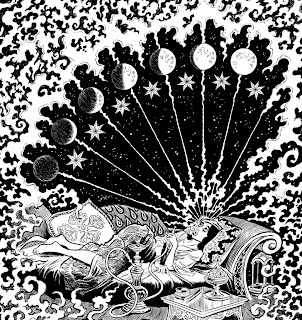Tuesday, January 10, 2012
Review: Habibi
Cementing his place as one of the most creative and artistically talented graphic novelists I've had the pleasure to read, Craig Thompson's Habibi is a breathtaking meditation on the meaning and strength of love in a cruel and unforgiving world. Illustrated in gorgeous ink-and-brush that will pull you in, Habibi is one in a million.
Set in a blistering desert world of myths and legends colliding with modern industrial greed and cruelty, Habibi is the story of two orphans, Dodola and Zam, who cling to one another in an effort to survive and prosper against the odds. It offers insight into the plight of the people whose suffering supports a corrupt system. Juxtaposed to the trials that Dodola and Zam face are the mysterious and transcendent tales of religion and myth Doloa uses to teach and entertain Zam. As they grow up, apart, and back together again in ways they never expected, these two used and abused youths must find their place.
Split between sections following Dodola's journey and then Zam's, Habibi begins when Dodola is sold into marriage at age 9 by her destitute parents. Misfortune leads her to slavery by age 12, when she adopts the young and defenseless Zam. The two soon escape, and spend the next nine years fending for themselves in the desert. During this time, Dodola is both a mother and sister to Zam, just as Zam is her child. When tragedy separate the two, Dodola into the harem of the sultan, and Zam into the filthy and dangerous city, it will be years before they reunite. And once they do, things will never be the same.
This story encompasses so much, is so dynamic, that I feel that I am ill equipped to give it the review it deserves without giving too much away. The book's website describes the book's concept thus: "At once contemporary and timeless, HABIBI gives us a love story of astounding resonance: a parable about our relationship to the natural world, the cultural divide between the first and third worlds, the common heritage of Christianity and Islam, and, most potently, the magic of storytelling."
The story is rich and nuanced, interlacing politics, religion, and interpersonal conflict effortlessly. Thompson's detailed and lush illustrations demand to be pored over again and again. Every new twist and turn, every new character is full of surprises and secret depths. For fans of Thompson's previous graphic novel, Blankets, the intricacy of his storytelling and the trappings of his art will be familiar, but the setting will not. It is a big leap from the bleak and snowy desolation of Wisconsin to the hot and exotic dunes of an Oriental desert. The flavor of the story is also very different. While Blankets is beautifully told, it is very much a straight forward autobiography. It's a huge show of artistic strength for Thompson to make such a departure. I really admire the breadth of knowledge he displays in creating a believable Middle Eastern world, build on a foundation on realism instead of cliche.
The relationship between Dodola and Zam, the changes between their roles and what they mean to each other, the fluxuation of danger, despair, and tragedy, and their unwavering devotion to one another may be one of the most satisfying I've ever seen in a work of fiction. In the end, it's up to them to save one another.
I cannot recommend this book enough. The sight of it may be intimidating (672 pages!), but I read it in only about two hours, during which I never put it down. A+++++ As close to a perfect graphic novel as I've seen.
P.S. - Yeah, I included as much of the art as I could in this review, much more than usual. Because, oh my god, it is sooooo beautiful.
Subscribe to:
Post Comments (Atom)





No comments:
Post a Comment